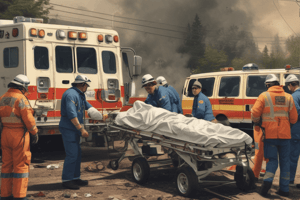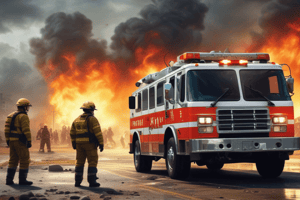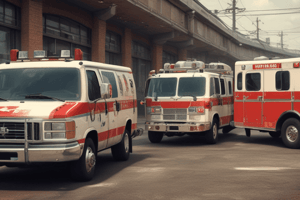Podcast
Questions and Answers
What are the physical symptoms of a head injury or concussion?
What are the physical symptoms of a head injury or concussion?
- Light sensitivity, mood changes, and restlessness
- Blacking out, seeing 'stars' or lights, and nausea (correct)
- Blurred vision, memory problems, and disorientation
- Tinnitus, uneven pupil sizes, and bleeding at the scalp
What is the recommended action to take after a concussion?
What is the recommended action to take after a concussion?
- Keep the person alone for the first 24 hours
- Apply ice to reduce swelling and immobilize the head
- Call 911 and keep checking cognitive abilities (correct)
- Let the person sleep and wake them up once every 15 minutes
What cognitive symptoms may indicate a head injury or concussion?
What cognitive symptoms may indicate a head injury or concussion?
- Feeling dazed, slurred speech, and post-traumatic amnesia
- Restlessness, lack of motor coordination, and tinnitus
- Blurred vision, light sensitivity, and nausea
- Memory problems, disorientation, and mood changes (correct)
How often should a person with a concussion be woken up during the first 24 hours?
How often should a person with a concussion be woken up during the first 24 hours?
What is the purpose of applying ice after a head injury?
What is the purpose of applying ice after a head injury?
What physical symptom might indicate a serious head injury?
What physical symptom might indicate a serious head injury?
What is the significance of not leaving the person alone for the first 24 hours after a concussion?
What is the significance of not leaving the person alone for the first 24 hours after a concussion?
What should be done if someone experiences post-traumatic amnesia after a head injury?
What should be done if someone experiences post-traumatic amnesia after a head injury?
What does DBAP-BTLS stand for in head-to-toe assessments?
What does DBAP-BTLS stand for in head-to-toe assessments?
When conducting head-to-toe assessments, what should CERT volunteers look for in all parts of the body?
When conducting head-to-toe assessments, what should CERT volunteers look for in all parts of the body?
What should CERT volunteers do if the patient is conscious during a head-to-toe assessment?
What should CERT volunteers do if the patient is conscious during a head-to-toe assessment?
What should CERT volunteers suspect in all unconscious survivors during head-to-toe assessments?
What should CERT volunteers suspect in all unconscious survivors during head-to-toe assessments?
What should CERT volunteers always check for during a head-to-toe assessment?
What should CERT volunteers always check for during a head-to-toe assessment?
What is the main objective when CERT members encounter suspected injuries to the head or spine?
What is the main objective when CERT members encounter suspected injuries to the head or spine?
What are the signs of closed-head, neck, or spinal injuries?
What are the signs of closed-head, neck, or spinal injuries?
What should CERT members do if survivors are exhibiting signs of closed-head, neck, or spinal injuries?
What should CERT members do if survivors are exhibiting signs of closed-head, neck, or spinal injuries?
What should CERT members do if they need to move patients with suspected head, neck, or spinal injuries?
What should CERT members do if they need to move patients with suspected head, neck, or spinal injuries?
What is the timeframe for urgent evacuation priorities?
What is the timeframe for urgent evacuation priorities?
What details must be documented for tourniquet application?
What details must be documented for tourniquet application?
What is the purpose of the head-to-toe assessment?
What is the purpose of the head-to-toe assessment?
What does the DCAP-BTLS acronym help to remember during a rapid assessment?
What does the DCAP-BTLS acronym help to remember during a rapid assessment?
When should the assessment be performed?
When should the assessment be performed?
What are the initial steps taken by CERT volunteers in a medical emergency?
What are the initial steps taken by CERT volunteers in a medical emergency?
What is crucial for effective medical emergency response?
What is crucial for effective medical emergency response?
How should first responders identify casualties?
How should first responders identify casualties?
Flashcards are hidden until you start studying
Study Notes
Medical Emergency Response Procedures
- Casualty identification involves using the first letter of the casualty’s first and last name, and the last four numbers of their social security number.
- Evacuation priorities are categorized as urgent (within 30 minutes), priority (within 24 hours), and routine (within 72 hours).
- Recording the casualty’s gender, date, time of injury, service branch, unit, allergies, mechanism of injury, and vital signs is crucial.
- Tourniquet application details for each limb, including type and time of application, must be documented.
- Evacuation priority, circulation hemorrhage control interventions, airway and breathing interventions, and medication details are recorded for treatment.
- Conducting head-to-toe assessments is essential, focusing on severe bleeding, low body temperature, airway obstruction, and determining the nature of the patient’s injury.
- The head-to-toe assessment aims to determine the extent of injuries, required treatment, and document injuries, emphasizing the use of personal protective equipment (PPE).
- The DCAP-BTLS acronym is used to remember what to look for during a rapid assessment (Deformities, Contusions, Abrasions, Punctures/Penetrations, Burns, Tenderness, Lacerations, and Swelling).
- The assessment should be performed before initiating treatment, unless the patient requires immediate care to prevent serious injury or death.
- First responders should record their name and the last four numbers of their social security number.
- Rapid treatment and assessment are the initial steps taken by CERT volunteers in a medical emergency to provide necessary care and determine the patient’s needs.
- The importance of following the specified procedures, including wearing PPE during assessments, is highlighted for effective medical emergency response.
Studying That Suits You
Use AI to generate personalized quizzes and flashcards to suit your learning preferences.




